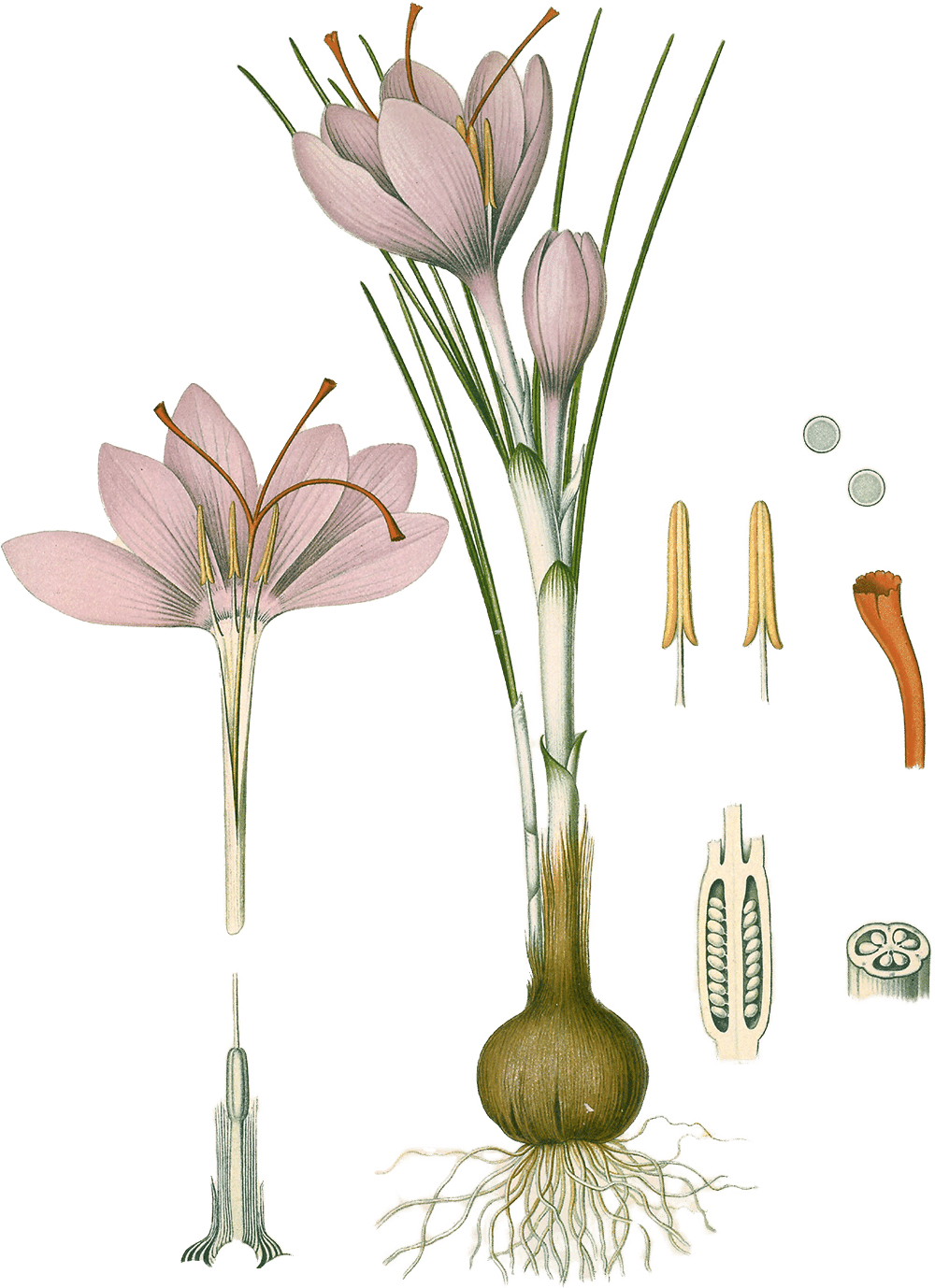Saffron #

Illustration of Crocus sativus L. from Köhler's Medizinal-Pflanzen (1887)
Saffron (Crocus sativus L.) is a culinary spice and dye from the Iridaceae family,1 originating in the region(s) of Greece.2 It is used for its stigma (style), primarily for bouillabaise, rice; fevers. Its aroma is described as pungent, bitter, with a heat index of 0.3
| English | Arabic | Chinese | Hungarian |
|---|---|---|---|
| saffron | زعفران | 藏紅花 | sáfrány |
Overview #
| id | saffron |
|---|---|
| species name | Crocus sativus L. |
| family | Iridaceae |
| part used | stigma (style) |
| macroarea | Mediterranean |
| region of origin | Greece |
| cultivation | Iran; Spain; Kashmir; etc. |
| color | deep red; dyes in orange |
| botanical database | POWO |
Etymologies #
English saffron, ca. 1200; cf. Middle English saf(f)rǒun < French safran ‘id.’, c. 1150; cf. Middle Low German safferân, Middle Dutch saffraen (Dutch saffraan), Middle High German saffrân (modern German safran) < Medieval Latin saffrānum ‘id.’ < Arabic زعفران zaʿfarān ‘id.’, (not connected with ṣafrā’ feminine of aṣfar ‘yellow’); cf. Turkish, Persian, and Hindi; Jewish Aramaic zaʿperānā; Spanish azafran, Portuguese açafrão; the word without this prefix gives rise to Italian zafferano, zaffrone, Provençal safran, safrá, Catalan safrá, French safran, medieval Latin safranum, medieval Greek ζαϕρᾶς zaforás, modern Greek σαϕράνι safráni, Russian šafran.
Arabic زعفران zaʿfarān ‘saffron’, (not connected with ṣafrā’ feminine of aṣfar yellow); cf. Turkish, Persian, and Hindi; Jewish Aramaic zaʿperānā; Spanish azafran, Portuguese açafrão; the word without this prefix gives rise to Italian zafferano, zaffrone, Provençal safran, safrá, Catalan safrá, French safran, medieval Latin safranum, medieval Greek ζαϕρᾶς, modern Greek σαϕράνι, Russian šafran. < Pahlavi zarparān ‘saffron’ [golden thread ], zar ‘gold’ + par ‘feather’ + -ān ‘pl.’, a pseudo-etymological explanation < Akkadian azupīru, azupīrānu ‘a spice and medicinal plant’, (unlikely etymon)
Mandarin Chinese 番紅花 fānhónghuā ‘saffron’ [foreign-red-flower ], reached China from way of Kashmir and Tibet, hence the synonyms 藏紅花 zànghónghuā [Tibetan-red-flower ], 西紅花 xīhónghuā [western-red-flower ]
Names #
English #
| term | source |
|---|---|
| saffron | OED |
Arabic #
| script | term | literal | source |
|---|---|---|---|
| زعفران | zaʿfarān | Wehr, 1976 | |
| حص | ḥuṣṣ | Wehr, 1976 | |
| جادي | jādī | Baalbaki, 1995 |
Chinese #
| script | term | literal | source |
|---|---|---|---|
| 番紅花 | fānhónghuā | foreign-red-flower | Defrancis, 2003 |
| 紅花 | hónghuā | red-flower | Laufer, 1919 |
| 西紅花 | xīhónghuā | western-red-flower | CHMD |
| 藏紅花 | zànghónghuā | Tibetan-red-flower | Kleeman, 2010 |
| 撒法郎 | sǎfǎláng | Laufer, 1919 | |
| 咱夫藍 | záfūlán | Laufer, 1919 | |
| 鬱金香 | yùjīnxiāng | yü-gold-aromatic | Schafer, 1985 |
POWO. (2022). Plants of the World Online (Botanical Database). Facilitated by the Royal Botanic Gardens, Kew. http://www.plantsoftheworldonline.org/ ↩︎
van Wyk, B.-E. (2014). Culinary Herbs and Spices of the World. University of Chicago Press, joint publication with the Royal Botanic Gardens, Kew. https://doi.org/10.7208/chicago/9780226091839.001.0001 ↩︎
Medicinal Spices Exhibit. (2002). UCLA Biomedical Library: History & Special Collections. https://unitproj.library.ucla.edu/biomed/spice/index.cfm?spicefilename=taste.txt&itemsuppress=yes&displayswitch=0 ↩︎